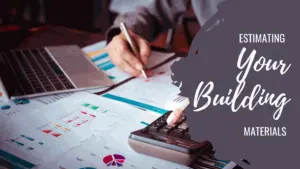Estimating Your Building Materials is the typical role of the Quantity Surveyor. The Architect is aware of what the QS does to fulfill his role. The QS role can be likened to that of an accountant in the construction industry.
In estimation, the list is presented in two formats. Either as a Bill of Quantities (BOQ) or as a Schedule of Materials (SOM).
A Schedule of Materials is a list and quantity of materials to get the work done. In simpler terms, think of the list you write when you want to cook soup. With a schedule of materials, anyone can go to the market to buy the materials on the list.
A Bill of Quantities details the volume or quantity of work to be done, in line with the example I gave above, it will be presented as such; you need to cook a fifty-litre pot of soup.
The list presented to you as the client depends on the type of contract you entered with the Contractor. If you desire to supply the materials for your building construction, you will be given the SOM. This provides you information on the materials you are buying and the quantity you will need to buy. It does not include pricing for the list.
Read Also: The Role of an Architect in Construction Supervision and Moiety Payments.
The BOQ is used by the contractor because he is the one actually doing the job. The QS prepares an unpriced BOQ that will be given to the contractor. The contractor conducts his own market survey and produces the priced BOQ.

The estimation of building materials is a tedious job. For small projects, you might be able to get away with a little calculation. However, major projects require expertise and lots of market surveys.
To conduct a small-scale estimation, you need to list the basic building materials used in Nigeria and their standard of measurement. The standard of measurements for works to be done are measured in length, width, height, area, and volume, as applicable.
Read: How to Effectively Read a Floor Plan like a Pro.
For instance, you desire to build a 30-metre-long wall, at a height of 3 metres. The area will be 30 multiplied by 3, which is 90. With this figure, the number of blocks will be determined, as well as cement, sand, water, labour costs, and the time frame required to finish the work.
Another way to do this on the go is to use a house material cost calculator. This saves you time, but you will need to know the materials to input into the calculator.
In the building industry, the Architect coordinates all these other professionals with the goal of completing your project within a timeframe and a budget.
The essence of a BOQ or SOM is cost control, to keep a tight grip on expenses in the course of construction. To an Architect, it is regarded as an extra paid service when rendered to you.
Want to make a minor alteration, but you do not know what you need? Let’s help you. Contact us via email or WhatsApp.


